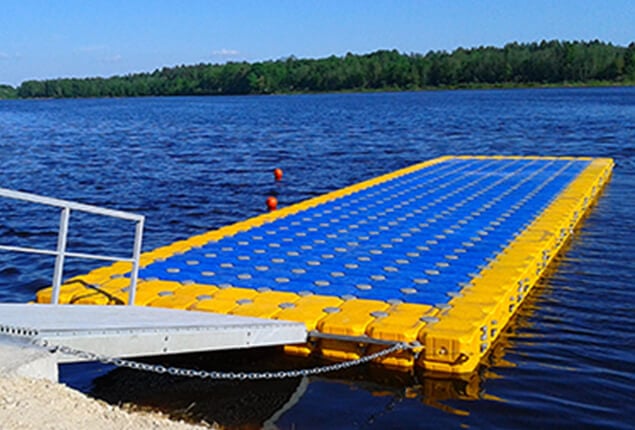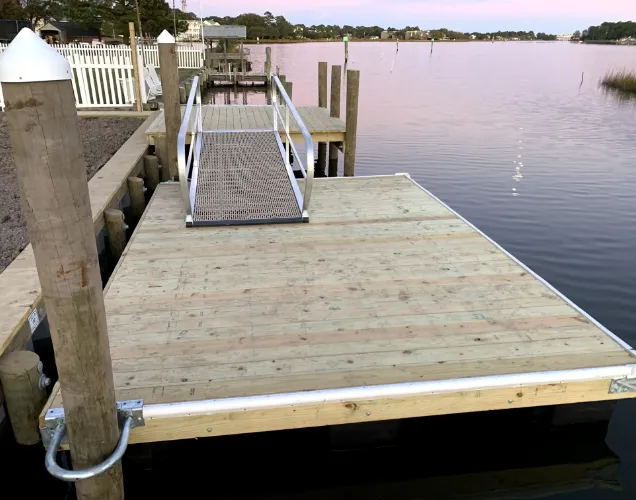Floating Docks: The Smart Option for Modern Beachfront Living and Entertainment
Floating Docks: The Smart Option for Modern Beachfront Living and Entertainment
Blog Article
Upgrade Your Waterfront With Sturdy Floating Docks
Updating your waterfront with long lasting floating docks can considerably improve both functionality and appearances, supplying a flexible solution for different water tasks. With a range of materials readily available, consisting of low-maintenance options and standard timber, picking the right dock can match your personal design and fulfill sensible needs.
Benefits of Floating Docks
Floating docks offer a wide range of advantages that enhance their allure for different maritime applications. Unlike traditional set docks, floating docks rise and loss with the trend, guaranteeing consistent accessibility for watercrafts and watercraft regardless of ecological conditions.
Additionally, floating docks are much easier to transfer and set up, providing adaptability for short-term or seasonal usage. Their modular style allows for modification to fit particular demands, whether for personal marinas, residential beachfronts, or industrial applications.
In addition, floating docks develop minimal disruption to the aquatic environment, protecting neighborhood communities and lowering the possibility of disintegration. They additionally offer improved safety and security and security for users, as their resilient nature supplies a more forgiving surface area than inflexible structures.
Additionally, floating docks can help with a varied array of activities, such as fishing, swimming, and leisure boating, making them a beneficial property for beachfront growth. Their versatility and functionality make floating docks a favored selection for a selection of naval projects.
Choosing the Right Materials
Selecting suitable materials for floating docks is important to their durability, performance, and overall efficiency. When choosing materials, consider aspects such as environmental exposure, maintenance needs, and architectural integrity. Typical products include wood, plastic, aluminum, and composite choices, each offering unique advantages and drawbacks.
Wood, while visually pleasing, requires regular maintenance to stop rot and decay. Pressure-treated timber can boost durability, but it might still surrender to water damages with time. Plastic drifts, commonly made from high-density polyethylene, are resistant to corrosion and require marginal maintenance, making them an appealing option for low-maintenance applications.
Aluminum is an additional sensible choice, understood for its strength and lightweight homes. It is resistant to corrosion and can stand up to extreme weather problems, although it might be extra costly than other products. Composite products integrate the most effective characteristics of timber and plastic, providing a low-maintenance and resistant option that mimics the look of wood without the linked drawbacks.
Inevitably, the option of material must align with the planned use, ecological considerations, and budget restraints, guaranteeing a functional and long lasting floating dock that satisfies your particular demands.
Setup Process Introduction
The effective setup of a drifting dock relies on mindful planning and implementation, ensuring that it runs effectively in its designated environment. The initial step involves examining website conditions, consisting of water deepness, shoreline functions, and prevailing weather condition patterns, which will certainly educate the dock design and anchoring system.
Complying with the website assessment, the next phase is to prepare the floating dock components. This consists of constructing the structure, securing floats, and affixing any kind of necessary hardware. It is vital to ensure that all links are robust and water-resistant to stand up to aquatic try these out problems.
As soon as the dock is assembled, the installation process begins with positioning the dock in the water. This can include a crane or various other training devices, specifically for bigger frameworks. Correct placement is necessary for functionality and safety.

Upkeep Tips for Longevity
Normal upkeep is necessary for guaranteeing the longevity and ideal performance of a drifting dock. To achieve this, start with routine examinations at the very least two times a year, focusing on the honesty of the dock's structure, consisting of the flotation tools and connecting equipment. Look for indications of rust, wear, or damages, and attend to any concerns promptly to avoid further degeneration.
Cleansing is another important facet of maintenance. Eliminate particles, algae, and barnacles from the dock's surface to avoid unsafe conditions and maintain aesthetic allure. Use a moderate cleaning agent and a soft brush to prevent harming the dock's products.
Additionally, make certain that the dock is correctly anchored and protected to hold up against seasonal changes in water levels and weather. Examine the anchoring system for security and make adjustments as required.
Enhancing Your Outside Visual
To create a visually appealing outside area, integrating a drifting dock can considerably improve the general aesthetic of your waterside property. Floating docks are not only useful but can additionally function as a striking prime focus that enhances the all-natural environments - floating dock services. Readily available in different materials and styles, these docks can be customized to match your residential or commercial property's architectural style and landscape
The addition of attractive elements, such as integrated lights or fashionable barriers, even more elevates the dock's visual allure. Think about utilizing all-natural timber finishes, which blend flawlessly with the atmosphere, or going with modern products like light weight aluminum or composite decking that offer a streamlined, contemporary appearance.
Tactically putting planters or seating locations on or around the dock can produce inviting rooms that motivate relaxation and satisfaction of waterfront views. In addition, integrating colors and structures that harmonize with your landscape will certainly produce a cohesive aesthetic throughout your outdoor location.

Verdict

Updating your waterside with resilient floating docks can dramatically enhance both functionality and looks, offering a flexible remedy for various water activities. Unlike conventional set docks, floating docks surge and autumn with the tide, making certain regular availability for boats and boat regardless of see environmental conditions.Picking ideal products for floating docks is crucial to their longevity, efficiency, and overall performance.When the dock is set up, the setup process starts with positioning the dock in the water.In summary, floating docks offer various benefits, including flexibility to water level adjustments and a range of product alternatives.
Report this page